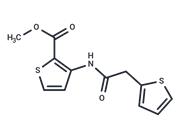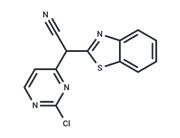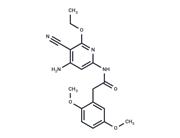| Name | JNK-IN-8 |
| Description | JNK-IN-8 (JNK Inhibitor XVI) is an irreversible JNK1/2/4 inhibitor (IC50: 4.7/18.7/1 nM) with over 10-fold selectivity compared to MNK2 and Fms, and no inhibition of Met, c-Kit, or PDGFRβ in the A375 cell line. |
| Cell Research | JNK-IN-8 is dissolved in DMSO and stored, and then diluted with appropriate media before use[1]. HEK-293 cells stably expressing Interleukin Receptor 1 (HEK293-IL1R) are cultured in Dulbecco's Modified Eagle's medium (DMEM) supplemented with 10% FBS, 2 mM glutamine and 1×antimycotic/antibiotic solution. Cells are serum starved for 18 h before incubation with DMSO or JNK-IN-8, stimulated with 2 μM Anisomycin for 1h and lysates are clarified by centrifugation for 10 min at 16000 g and 4°C[1]. |
| Kinase Assay | A375 cells are pre-treated with 1 μM JNK-IN-8 for the indicated amounts of time. Remove the medium and wash 3 times with PBS. Resuspend the cell pellet with 1 mL Lysis Buffer (1% NP-40, 1% CHAPS, 25 mM Tris, 150 mM NaCl, Phosphatase Inhibitor Cocktail, and Protease Inhibitor Cocktail). Rotate end-to-end for 30 min at 4°C. Lysates are cleared by centrifugation at 14000 rpm for 15 min in the Eppendorf. The cleared lysates gel filtered into Kinase Buffer (0.1% NP-40, 20 mM HEPES, 150 mM NaCl, Phosphatase Inhibitor Cocktail, Protease Inhibitor Cocktail) using Bio-Rad 10DG colums. The total protein concentration of the gel-filtered lysate should be around 5-15 mg/mL. Cell lysate is labeled with the probe from ActivX at 5 μM for 1 hour. Samples are reduced with DTT, and cysteines are blocked with iodoacetamide and gel filtered to remove excess reagents and exchange the buffer. Add 1 volume of 2X Binding Buffer (2% Triton-100, 1% NP-40, 2 mM EDTA, 2X PBS) and 50 μL streptavidin bead slurry and rotate end-to-end for 2 hours, centrifuge at 7000 rpm for 2 min. Wash 3 times with 1X Binding Buffer and 3 times with PBS. Add 30 μL 1X sample buffer to beads, heat samples at 95°C for 10 min. Run samples on an SDS-PAGE gel at 110V. After transferred, the membrane is immunoblotted with JNK antibody[1]. |
| In vivo | JNK-IN-8 (10 mM) effectively inhibits the phosphorylation of c-Jun stimulated by IL-1β in IL-1R cells. It displays significant selectivity for the 1,4-bis(phenylamino) and 1,3-aminobenzoic acid structural regions compared to imatinib, covalently binding to the Cys154 target via an N,N-dimethylbutenamide linkage. JNK-IN-8 inhibits the phosphorylation of c-Jun in HeLa (EC50: 486 nM) and A375 (EC50: 338 nM) cells. Its binding with PIK3C3, IRAK1, PIP5K3, and PIP4K2C significantly enhances selectivity and elimination rates. JNK-IN-8 inhibits JNK2 through Cys116. |
| Storage | Powder: -20°C for 3 years | In solvent: -80°C for 1 year | Shipping with blue ice. |
| Solubility Information | DMSO : 55 mg/mL (108.36 mM)
H2O : < 1 mg/mL (insoluble or slightly soluble)
Ethanol : < 1 mg/mL (insoluble or slightly soluble)
|
| Keywords | JNKIN8 | Inhibitor | JNK | JNK IN 8 | inhibit | JNK-IN-8 |
| Inhibitors Related | Gilteritinib | Regorafenib monohydrate | Sorafenib | Astragaloside IV | Pexidartinib | Regorafenib | Sorafenib tosylate | (-)-Bornyl acetate | Anisomycin | Imatinib | Pazopanib | Axitinib |
| Related Compound Libraries | Highly Selective Inhibitor Library | Anti-Neurodegenerative Disease Compound Library | Pain-Related Compound Library | Bioactive Compound Library | Membrane Protein-targeted Compound Library | Tyrosine Kinase Inhibitor Library | Kinase Inhibitor Library | Inhibitor Library | Anti-Aging Compound Library | Bioactive Compounds Library Max |

 United States
United States



